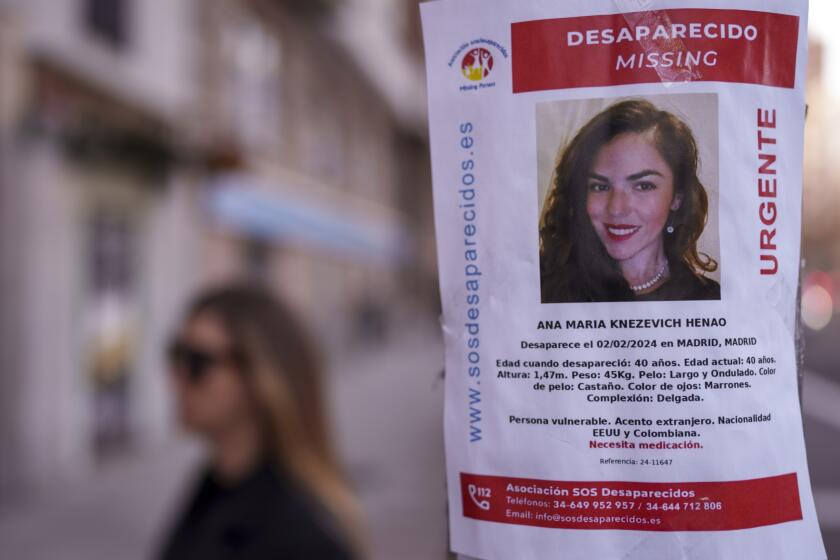BOOK REVIEW : Blacks, the Catholic Priesthood : DESEGREGATING THE ALTAR: The Josephites and the Struggle for Black Priests 1871-1960 <i> by Stephen J. Ochs</i> , Louisiana State University Press, $39.95, 500 pages
In the formative centuries of the undivided Christian church, Stephen Ochs reminds us in “Desegregating the Altar,” Old World blacks were admitted to holy orders along with everyone else; if exception was taken by anyone, historians don’t seem to know about it.
But by the late 19th Century in liberty-loving America, the chances of a black man becoming a Roman Catholic priest were right up there with a rich man’s getting into heaven.
Here, after all, was a country where Jesuits had owned slaves and abolitionists were maligned as “deadly enemies of the Church”; where deceased black Catholics were excluded from white cemeteries; where black nuns in religious habit were bumped off the sidewalks by fellow communicants.
In such an atmosphere, the notion that a black might qualify to inhabit the sacred precincts of the priesthood--in which the faithful regard the clergy as but a notch or two beneath Jesus--was one white Catholics could dismiss out of hand.
That was not the view of the St. Joseph’s Society of the Sacred Heart, and the lonely struggle these few Josephites undertook (before losing their nerve) to foster equality at the altar is the thrust of Ochs’ meticulous history. It is an account that makes one squirm.
Even the trailblazers were not unalloyed moral heroes; they harbored racist stereotypes themselves. Fair play and distributed justice were less the issue than the practical expedient of recruiting an “indigenous clergy” better fitted than whites for recruiting more blacks for (and more power to) the church. The church envied the evangelizing successes of non-Roman Catholic Christians who had overcome reservations toward ordaining black ministers and building up black congregations.
But the Josephite’s specialized ministry with blacks, even if smirched, eventually brought in a better day. Although black discontent can still be found (the Rev. George Stallings Jr., a priest in Washington, D.C., recently broke away, charging that now as always the church subordinates black concerns), the Roman Catholic priesthood of the present is moving well beyond tokenism, according to Ochs.
It was the Rev. John R. Slattery who, as superior general of the St. Joseph’s order at the turn of the century, engineered the first ordinations of black men in the United States. (These were the first times too, Slattery wryly remarked later, that blacks got good seats in cathedrals.) He managed this by founding in Baltimore a Josephite preparatory college and a companion seminary through which he could steer promising black candidates.
Most of the church hierarchy viewed the venture with either skepticism or hostility, and even Slattery shared some of the former. On the argument that black men were less able than whites to live the chaste lives demanded of priests, black candidates for Slattery’s seminary would not be considered until they had passed their 30th birthdays. Whites were admitted at age 20.
These too were the days when the croak of Jim Crow was widely heard in our land, and notwithstanding the support of some bishops, the corrosive opposition Slattery encountered in others (fearful or biased men who refused, both in the North and the South, to accept or to place black priests in desirable parishes) took its toll. At first Slattery himself, choosing caution over conviction, backed away from pressing his case too vigorously; then, becoming thoroughly embittered, he left the church altogether, married, and took to writing such denunciations as “there is no hope of reforming the Catholic Church . . . “ and “the stand of the Catholic Church toward the negro (sic) is sheer dishonesty.”
Relieved to be rid of Slattery’s discomfiting ways, other Josephites sought less problematical vineyards to tend, while the smallish Divine Word Missionaries down in Mississippi took up some of the slack with an unblushing tactic of their own: a segregated seminary.
And the movement might have languished right there but for a black Catholic biology professor with high dudgeon, deep faith--and the canny background of an NAACP executive. Thomas Wyatt Turner organized other black Catholics, drew Rome’s attention, and at length helped rekindle amid the Josephites some of John Slattery’s earlier zeal. Maybe it took four decades, but by the 1940s the Society of St. Joseph was once again gingerly preparing black priests--and nowadays does so enthusiastically.
As Turner once summed up the situation: If the church dealt with racial prejudice as it does with other violations of the Ten Commandments, “the monstrous falsehood would soon die.” Were he alive today, he’d still be waiting, but he might be more hopeful.
Ochs’ history is an exhaustive--sometimes exhausting--but sensitive examination of a specific instance of the mournful racism that afflicts Christians of all stripes, slovenly and earnest, past and present.
Next: Elaine Kendall reviews “Something Blue” by Ann Hood (Bantam).
More to Read
Start your day right
Sign up for Essential California for news, features and recommendations from the L.A. Times and beyond in your inbox six days a week.
You may occasionally receive promotional content from the Los Angeles Times.






